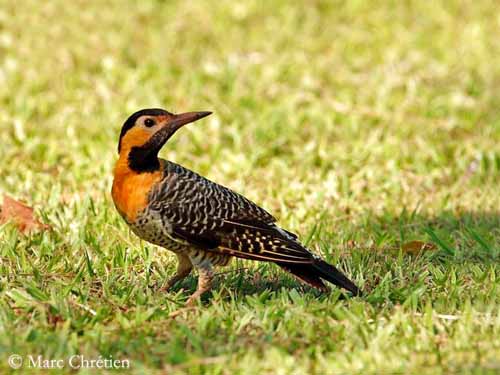
Campo Flicker
Colaptes campestris
Piciforme Order – Picidae Family
BIOMETRICS:
Length: 28-31 cm
Weight: 145-192 g
DESCRIPTION:
The Campo Flicker is a colourful woodpecker from South America. This woodpecker may nest both in trees in wooded areas, and in mud banks and termites mounds in treeless regions.
Adult male has blackish upperparts barred pale brown and whitish, with broader pale bars on scapulars and wing coverts. The dark brown flight feathers are finely barred buffy-white.
The rump is white and may be variably spotted or barred dark, whereas the uppertail coverts are barred brown and white. The tail is brownish-black with narrow buff bars on outer webs and on inner webs of central rectrices.
Fr : Pic champêtre
All : Feldspecht
Esp : Carpintero campestre
Ital : Picchio di campo nordico
Nd : Campogrondspecht
Port: pica-pau-do-campo
Photographers:
Philippe Wolfer
OISEAUX D’ARGENTINE
Eduardo Andrés Jordan
MIS AVES – AVES DE ARGENTINA
Marc Chrétien
MURINUS
Text by Nicole Bouglouan
Sources:
HANDBOOK OF THE BIRDS OF THE WORLD Vol. 7 by Josep del Hoyo-Andrew Elliott-Jordi Sargatal – Lynx Edicions – ISBN: 8487334377
BirdLife International (BirdLife International)

On the underparts, chin and throat are black. The chin is often flecked white. The breast is golden-yellow. The rest of underparts is creamy-white with fine black bars.
Underwing is yellowish with darker tip and trailing edge. Undertail is as above.
On the head, male has black forehead, crown and nape. The black colour ends in a point on the nape. Lores and the area around the eyes are buffy-white. The malar area shows red and buff feather tips. Ear-coverts and neck are golden-buff.
The straight bill is black. It has broad base and pointed tip. Eyes are reddish-brown. Legs and feet are pinkish-grey.
The female has similar plumage except the malar area which is whitish and black, without any red colour.
The juvenile is duller, with broader black bars and duller golden areas.
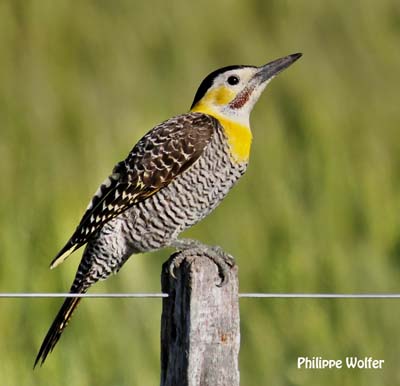
The race Colaptes campestris campestroides differs mainly in white or creamy-white chin and throat, making conspicuous the dark malar stripe, reddish in male.
The underparts often show narrower black bars, and the belly is almost plain.
The female has black and white malar stripe.
VOICE: SOUNDS BY XENO-CANTO
The Campo Flicker utters loud whistles in series of two or three notes.
The location call is a series of “week” or “keep”. We can also hear wavering series of different notes “wewwwew”, “gwik”, “pya”… and fast series of “wick” in close contact call.
The race campestroides gives higher-pitched calls.
HABITAT:
The Campo Flicker frequents savannahs, grassland, campos, farmland and edges. It is also found in caatinga (arid thorny scrub), clearings and forest edges.
The race campestroides is often seen in open pampas, forest edges and clearings.
The locations with termite nests, fence posts and trees are suitable nesting habitat for this species.
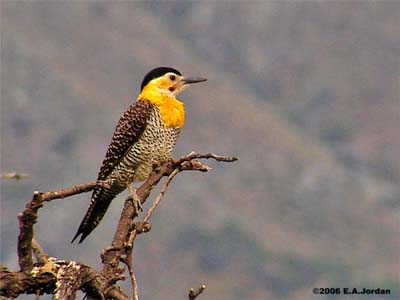
RANGE:
Both races of Campo Flicker share the large range, occupying almost all the eastern part of South America, Surinam, Brazil, Bolivia, Paraguay, Uruguay and NE Argentina.
The Campo Flicker is resident in its range, with probably some dispersion.
BEHAVIOUR:
The Campo Flicker feeds primarily on ants and termites, adults and larvae. It also takes bugs, grasshoppers and nestlings.
It often feeds on the ground in small groups of up to 8 birds. It forages among the stones, the fallen logs. It visits termite mounds, anthills, isolated trees, cacti and rocks.
When foraging, it walks on the ground, and hops over longer distances. It opens the large mounds of termites. It also may break into nests of Rufous Hornero to take the nestlings.
The Campo Flicker hammers large holes into buildings, probably for roosting or storing food.
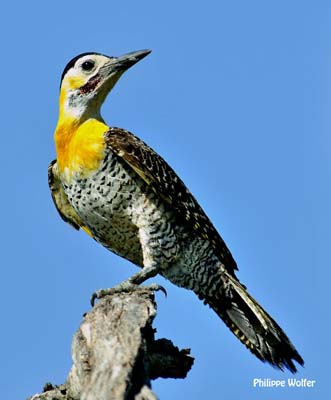
During the breeding season, the male defends the nest-site vigorously. If another woodpecker approaches, conflicts occur, starting with excited calls, followed by some aggressive displays such as flicking wings and swinging movements of head and body. If the intruder insists, there is a physical combat with bill and feet used as weapons. Both birds fight in the air, but fairly low from the ground, with bill and legs stretched forwards. These fights usually occur between individuals of the same sex, and each time with a single bird.
The Campo Flicker is able to chase away from the nest-site birds of prey by mobbing if the nest is threatened.
Courtship displays involve fluttering wings and spreading of wings, in order to expose the bright yellow pattern of the underwing. Other displays are probably performed, but they are poorly known.
FLIGHT:
The Campo Flicker has undulating flight, with periods of active wing beats interspersed with glides.
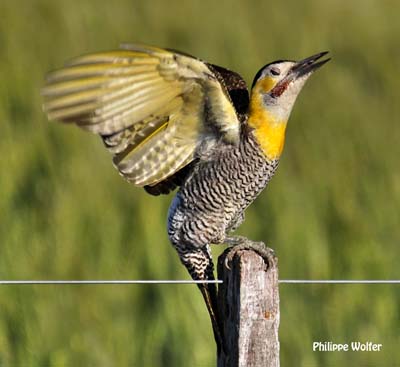
REPRODUCTION:
Breeding season occurs in January-April in northern parts, and in August-November in southern parts of the range.
The Campo Flicker sometimes nests in loose colonies of 5-6 nests / 100 metres along the forest edges.
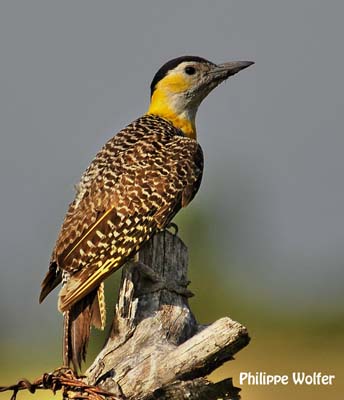
The nest is excavated at about 12 metres above the ground in tree trunk, dead stump, large fence post or even in nest of arboreal termites. But in treeless regions, the nest is made in mounds of terrestrial termites or in mud banks.
Female lays 4-5 eggs. Incubation is shared by both parents. Adults feed the young by regurgitation of ants and termites. They carry the food in the oesophagus and regurgitate directly into the mouth of the young.
Parents and young stay together for long time after nesting period.
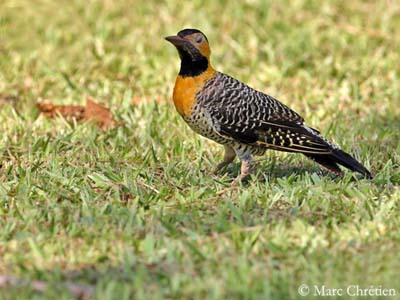
DIET:
The Campo Flicker feeds mainly on ants and termites and their broods. But it also takes beetles, grasshoppers and nestling.
It forages in small groups on the ground.

PROTECTION/THREATS/ STATUS:
The Campo Flicker is common in its range. It also occurs in protected areas. This open-country species benefits from deforestation and clearing for roads.
This species is not threatened at this moment.